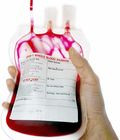Blood transfusion
 Blood transfusion has saved the lives of countless people and animals. The technique was developed when treated blood was shown to be safe for transfusion in dogs in 1914. Blood banks and routine blood donation followed.
Blood transfusion has saved the lives of countless people and animals. The technique was developed when treated blood was shown to be safe for transfusion in dogs in 1914. Blood banks and routine blood donation followed.
Early research
In 1667 the Frenchman Prosper Denis transferred the blood of a lamb into a young man. Severe anaemia occurred and thus the concept of transfusion fell out of favour. However, the main reason transfusion was not more often attempted or even researched was that it was a technically difficult procedure - the only available apparatus were animal quills or silver tubes - and there was no way of preventing blood from clotting. Even after Karl Landsteiner defined the blood groups in 1900, and recipients and donors could be precisely matched, transfusion was a risky procedure.
Key developments in blood transfusion techniques
• Animal experiments over the years 1900-1916 gradually enabled transfusion to become the routine technique it is today. The key developments were:
• George Crile (1907) perfected the technique of transfusion from artery to vein using dogs, and described its application in 32 patients.
• Hustin (1914) showed that addition of sodium citrate could prevent blood from clotting and that citrated blood could be safely transfused into dogs.
• Richard Lewisohn (1915) determined the maximum amount of citrate that could be transfused into dogs without toxicity and thus determined the optimum concentration that could be added to blood for the best anticoagulant effect.
• Weil (1915) showed that citrated blood could be stored for 2 days and still be effective when transfused into guinea-pigs and dogs which had lost blood.
• Rous and Turner (1916) used rabbits to demonstrate that, with certain additives and proper treatment, citrated blood could be stored for 14 days and still be successfully transfused.
Through these animal experiments, the prolonged storage of blood without clotting thus became possible, so enabling the establishment of blood banks, and blood transfusion as a routine procedure.
IMAGE©ISTOCKPHOTO.COM/RONEN



